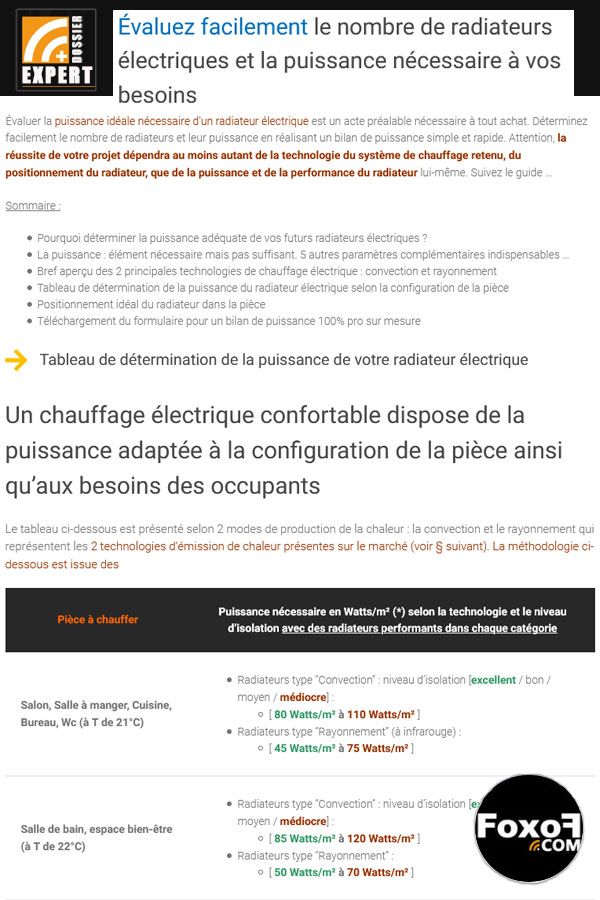Home / Heating / Electric Heating / Infrared Heating / Guide / How to assess the number and power of infrared heaters in a room? (español – italiano – français)
Easily estimate the number of electric heaters and the heat output required for your needs
Share this page
Evaluating the ideal power requirement of an electric heater is a necessary prerequisite to any purchase. Easily determine the number of heaters and their output by performing a quick and easy power balance. Please note that the success of your project will depend at least as much on the technology of the heating system chosen, the positioning of the heater, as on the power and performance of the heater itself. Follow the guide…
Contents:
- Why determine the right wattage for your future electric heaters?
- Power: necessary but not sufficient. 5 other essential complementary parameters…
- Brief overview of the 2 main electric heating technologies: convection and radiation
- Table for determining the power of the electric heater according to the configuration of the room
- Ideal positioning of the heater in the room
- Download the form for a 100% professional power assessment
Why determine the right wattage for your future electric heaters?
+ Oversizing is unnecessary. The «right power» allows you to:
- save living space. If the heater is less powerful, it will be smaller.
- reduce your budget. Less powerful, it will also be less expensive to buy.
– Under-sizing is «risky». The «right power» allows you to:
- maximise the thermal comfort of the occupants.
- provide a useful power reserve in case of exceptional harsh winters or occasional needs.

Our calculation guide below will answer your specific request (room, comfort need), whatever the heater technology you have chosen.
Power is not enough. 5 other additional parameters are essential for a successful heating project….
All in all, there are 5 things to pay attention to in any electric heating project with heaters!
- The configuration of the room to be heated (function, dimensions, ceiling height, insulation quality).
- The needs of the occupants in terms of comfort temperature (T room = 21°C, 22°C, etc.).
- The heating technology chosen (e.g. 1400W with a convector; equivalent to 700W with a high-end infrared heater).
- The performance of the heater (20 to 50% difference in performance between 2 radiators of the same technology).
- The positioning of the heater in the room (at the risk of degrading performance).
Brief overview of the 2 main electric heating technologies: convection and radiation
The video on the right shows:
- the principle of convection heating (the most common) where the cold air at the bottom of the heater is warmed by contact with the heater, then lighter than the air it accumulates (unnecessarily) at the ceiling only to fall back down as it cools.
- the principle of heating by radiation (infrared), which is much more efficient in terms of comfort and consumption.
Principle of radiant heating – Differences from convection
Table for determining the power of your electric heater
A comfortable electric heater has the right output for the room configuration and the needs of the occupants
The table below is presented according to 2 modes of heat production: convection and radiation which represent the 2 technologies of heat emission present on the market. The methodology below is taken directly from the manufacturers. It includes an uncertainty of about 10% on the insulation quality.
Whatever the technology of the heater, it aims to compensate for the heat loss of the dwelling (= insulation failure). This is why the table below takes into account the coldest average temperature of the year (according to the history of the region).
| Room to be heated | Power requirement in Watts/m² (*) depending on technology and insulation level avec des with efficient heaters in each category |
|---|---|
| Living room, Dining room, Kitchen, Office, WC (T at 21°C) |
|
| Bathroom, wellness area (T at 22°C) |
|
| Bedroom (T at 19°C) |
|
| Mobil Home, Boat, Atypical spaces (T at 20°C) |
|
The above table serves as a basis. The value identified in the table should then be adjusted with the additional elements below.
Important additional calculation rules:
- Geographical areas (postcode):
- Add 5% power for the following regions: Wales, North West, Yorks/Humber, East Midlands, West Midlands.
- Add 10% power for the following regions: Scotland, Northern Ireland, North East.
- Altitude: add 10% for every 500 metres of altitude above 1500 metres.
- 2.5 metres < ceiling height < 3 metres: add 10% power. Beyond that, add 10% every 50 cm and absolutely avoid heating by convection (convection, inertia, accumulation, etc.) at the risk of heat being stored unnecessarily in the ceiling.
- Number of cold walls (i.e. walls in direct contact with the outside). (i.e. walls in direct contact with the outside). From 3 cold walls add 10% extra power. The ceiling is seen as a cold wall for flats on the top floor.
- Orientation to the sun: if the room is facing SOUTH and has more than 3 hours of significant sunlight (entering the room) then remove 10% of the power. If the room is facing NORTH then add 10% power.
- The desired target (room) temperature:
- Room T of 21°C = follow the table
- Room T > 21°C = add 7% power per additional degree desired.
- Room T < 21°C = remove 7% power per lower degree desired.
(*) Details of the insulation level (of the envelope = walls, floor, ceiling):
- [Excellent]: passive houses, BBC Effinergie+, housing that exceeds the standards and thermal regulations of your country currently in force (i.e. RT2012)
- [Good]: housing built after 2010, RT2012 housing (minimum thermal regulations of your country currently in force).
- [Average]: housing built between 2000 and 2010
- [Poor]: housing built before 2000
- Of course, this classification must be adapted to each individual case.
- In the case of a renovation the date of construction is no longer important, only the year of renovation is taken into account (assuming that the renovation was carried out according to the thermal standards in force in that year.
Please note. For complex spaces to be heated (see below), the applicable rules are no longer the same.
- Very high ceiling heights (> 4 metres).
- Very large interior open spaces (and large floor areas).
- Buildings that are very poorly insulated, difficult to insulate or simply not insulated.
- Premises with continuous opening/closing to the outside.
- Outdoor premises that are covered and sometimes exposed to the wind.
>> see the dedicated article: «how to heat complex spaces»
A noter. Pour les espaces complexes à chauffer (voir ci-dessous) les règles applicables ne sont plus les mêmes.
- Les très grandes hauteurs sous plafond (> 4 mètres).
- Les très grands espaces intérieurs ouverts (et grandes surfaces au sol).
- Les bâtiments très mal isolés, difficilement isolables ou simplement non isolables.
- Les locaux avec ouverture-fermeture continuelle sur l’extérieur.
- Les locaux en extérieur couvert et parfois exposés au vent.
>> voir l’article dédié : “comment chauffer les espaces complexes”
Examples of real-life electric heating sizing projects
Example Real project n°1: Appartement in London
Characteristics of the room to be heated: living room (3 m high ceiling), with very little insulation (not meeting current standards), with no significant solar gain. The room has only one cold wall on the outside (the front of the building as the building is adjoined on both sides). Desired room temperature: 21°C. Surface area of the room: 15 m² (L = 5 metres x W = 3 metres)
- Calculation with quality convection heaters / basic power used (see table): 100 Watts per m² + 10% ceiling height = 110 Watts per m², i.e. a heater of about 1700 Watts (110 Watts per m² x 15 m²).
- Calculation with high performance infrared radiant heaters / basic power used (see table): 65 Watts per m² + 10% ceiling height = 71 Watts per m², a heater of about 1000 Watts (71 Watts per m² x 15 m²).
- radiateurs rayonnants infrarouges haute performance / Puissance de base retenue (voir tableau) : 65 Watts par m² +10% hauteur sous plafond = 71 Watts par m², soit un radiateur de 1000 Watts environ (71 Watts par m² x 15 m²).
Example Real project n°2: Newly built house in East Midlands
Characteristics of the room to be heated: bedroom (2.4 m ceiling height), with good insulation (from 2009), without significant solar gain (north-facing). The room has a single cold wall on the outside. Desired room temperature: 20°C. Room surface area: 10 m² (L = 3.2 metres x W = 3.1 metres)
- Calculation with quality convection heaters / basic power used (see table): 80 Watts per m² +5% (geographical area) = 84 Watts per m², a heater of about 840 Watts (84 Watts per m² x 10 m²).
- Calculation with high performance infrared radiant heaters / basic power used (see table): 55 Watts per m² +5% (geographical area) = 58 Watts per m², a heater of about 580 Watts (58 Watts per m² x 10 m²).
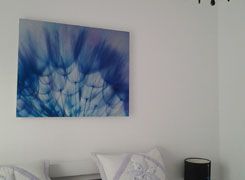
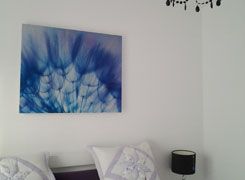
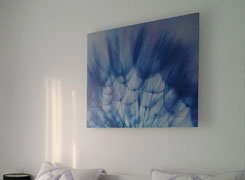
Example Real project n°3 : Secondary house in South East
Characteristics of the room to be heated: open-plan living room/kitchen (2.7 m average ceiling height), with average insulation (renovated in 2005), with no significant solar gain (even though it faces south). The room has 3 cold walls to the outside. Desired room temperature: 21°C. Room surface area: 35 m² (L = 6.5 metres x W = 5.5 metres)
- Calculation with quality convection heaters / basic power used (see table): 90 Watts per m² +5% (ceiling height) + 10% (3 cold walls) = 105 Watts per m², about 3700 Watts (105 Watts per m² x 35 m²). That is 2 heaters of 1500 Watts in the living room + 1 heater of 1000 Watts in the kitchen.
- Calculation with high performance infrared radiant heaters / basic power used (see table): 60 Watts par m² +5% (ceiling height) + 10% (cold walls) = 70 Watts per m², about 2450 Watts (70 Watts per m² x 35 m²). That is 2 heaters of 1000 Watts in the living room and 1 heater of 450 Watts in the kitchen.
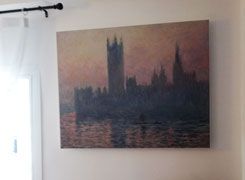
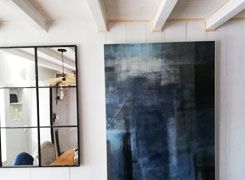
Example Real project n°4 : Pavilion of the 80’s in North East
Characteristics of the room to be heated: bathroom (2.5 m high ceiling), with poor insulation (partial renovation in 2000), with no significant solar gain (even though it faces south). The room has 3 cold walls on the outside. Desired room temperature: 23°C. Room surface area: 9 m² (L = 3 metres x W = 3 metres)
- Calculation with quality convection heaters / basic power used (see table): 110 Watts per m² +10% (region) + 10% (3 cold walls) + 14% (to heat up to 23°C) = 150 Watts per m², which is about 1350 Watts (150 Watts per m² x 9 m²). That is 1 heater of 1500 Watts.
- Calculation with high performance infrared radiant heaters / basic power used (see table): 75 Watts per m² + 10% (region) + 10% (3 cold walls) + 14% (to heat up to 23°C) = 100 Watts per m², which is about 900 Watts (100 Watts par m² x 9 m²). That is 1 heater of 900 Watts.
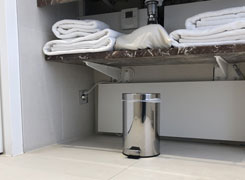
Performance of electric heaters: buying tips
1) We do not recommend the use of convectors.
2) For the range of inertia radiators, soft heat radiators or certain radiant panels, we recommend electric heaters with an energy label A (presence/absence detection, open window detection, consumption indication).
Beware of the aptitude coefficient, which reflects the performance of the radiator and should be as low as possible. For more information on this subject.
3) For the family of high-performance radiant heaters, we recommend the sub-family of far-infrared heaters. In this family we recommend heaters with a certified radiation rate of > 50%. As there is no standard for this element, we recommend requesting a study that justifies the radiation rate claimed by the distributor. These radiators cannot provide an aptitude coefficient as they do not «embed» a thermostat in the heater (which has many advantages). As the main manufacturers are German and Austrian, CE and TUV certification is the norm.
Read the article on The best electric heaters?
Ideal positioning of the heater in the room

Correct positioning of the heater influences comfort and consumption
The location of the radiator in the room should not be overlooked as, depending on the technology or heating system chosen, it can have a significant influence on the final performance (comfort and consumption).
For heaters with conventional technologies (convectors, inertia heaters, storage heaters, etc.) the positioning is less important than for heaters with high radiation rates. This is because convectors heat up the volume of the room little by little. Once the warm air has accumulated (unnecessarily) on the ceiling, the room is gradually «filled» with warm air.
However, this principle consumes a lot of energy and rarely provides lasting comfort by maintaining an even temperature over time and space.
For high-radiation heaters (such as far-infrared heaters), the positioning is essential because the principle is based on the accumulation of energy on the floor, walls and ceiling. The heat is then distributed evenly throughout the room. The radiator should therefore be positioned so that as many areas of the room as possible are covered by its radiation.
Read the article on The ideal positioning of a radiant heater
Download the blank form to get a 100% professional power assessment
Before buying a radiator, it is advisable to call on the services of an expert (ideally the manufacturer, an approved distributor, an installer, etc.) in order to assess the number of heaters required, their power and their positioning in the room.
This can be done completely remotely if you provide the necessary factual data. With the elements that can be downloaded below (which can be accompanied by architectural plans, simple sketches and/or photos) the expert will be able to calculate the appropriate power according to the electric heating technology he proposes.
DOWNLOAD THE POWER ASSESSMENT QUESTIONNAIRE to provide to the professional:
It is also possible to call on the services of a design office, which will carry out a thermal assessment taking into account the actual heat loss of each room. The heat output required for each room is determined. The corresponding radiators are then proposed.
Learn more about heaters and electric heating
Expert file: What are the characteristics of the ideal heater?
Expert file: How to heat a veranda efficiently?
How to choose an infrared heater: The best infrared heaters
EN-FOX65
